Two Deutsche Werke compressed air-driven telescoping
catapults were installed at the forward end of the flight deck for power-assisted launches. They were 23 m (75 ft) long and designed to accelerate a 2,500 kg (5,500 lb) fighter to a speed of approximately 140 km/h (87 mph) and a 5,000 kg (11,000 lb) bomber to 130 km/h (81 mph).
[19]
A dual set of rails led back from the catapults to the forward and midship elevators. In the hangars, aircraft were to be hoisted by crane - a method also proposed for the
Essex-class carriers of the United States Navy, but rejected
as too time-consuming - onto collapsible launch trolleys. The aircraft/trolley combination would then be lifted to flight deck level on the elevator and trundled along the rails to the catapult start points. When the catapults were triggered, a burst of compressed air would propel moveable slideways within the catapult track wells forward.
[20]
As each plane lifted off, its launch trolley would reach the end of the slideway but remain locked in place until the tow attachment cables were released. Once the slideways were retracted back into the catapult track wells and the tow cables unhooked,
the launch trollies would be manually pushed forward onto recovery platforms, lowered to the forecastle on "B" deck, then rolled back into the upper hangar for re-use via a secondary set of rails.
[20] When not in use, the catapult tracks were to be covered with sheet metal farings to protect them from harsh weather.
[19]
Eighteen aircraft
could have theoretically been launched at a rate of one every 30 seconds before exhausting the catapult air reservoirs. It would then have taken 50 minutes to recharge the reservoirs. The two large cylinders holding the compressed air were housed in insulated compartments located between the two catapult tracks, below flight deck level but above the main armored deck. This positioning afforded them only light protection from potential battle damage. The insulated compartments were to be electrically heated to a temperature of 20 °C (68 °F) in order to prevent ice from forming on the cylinder piping and control equipment as the compressed air was vented during launches.
[21]
It was intended from the outset that all of the
Graf Zeppelins' aircraft would normally launch via catapult. Rolling take-offs would be performed only in an emergency or if the catapults were inoperable due to battle damage or mechanical failure. Whether this practice would have been strictly adhered to or later modified, based on actual air trials and combat experience is open to question, especially given the limited capacity of the air reservoirs and the long recharging times necessary between launches.
[19] One advantage of such a system, however, was that the
Graf Zeppelins could have launched their aircraft without need for turning the ship into the wind or under conditions where the prevailing winds were too light to provide enough lift for her heavier aircraft. They could also have launched and landed aircraft simultaneously.
[22]
To facilitate rapid catapult launches and eliminate the necessity of time-consuming engine warm-ups,
[Note 1] up to eight aircraft were to be kept in readiness aboard the German carriers on their hangar decks by the use of steam pre-heaters. These would keep the aircraft engines at an operational temperature of 70 °C (158 °F). In addition, engine oil was to be kept warmed in separate holding tanks, then added via hand-pumps to the aircraft engines shortly before launch. Once the aircraft were raised to flight deck level via the elevators, aircraft oil temperature could be maintained, if need be, through the use of electric pre-heaters plugged into power points on the flight deck. Otherwise, the aircraft could have been immediately catapult-launched as their engines would already have been at or near normal operating temperature.
[23]
